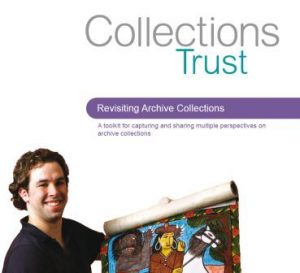
Revisiting Archive Collections is available via Collections Trust
At the heart of any archive service are its collections: if we didn’t hold historical records, we wouldn’t be archive services. A huge proportion of the work of any archive service is in making collections available – whether that means by ensuring they are in good enough condition to be handled; digitising them; supporting researchers to find and read unfamiliar sources and getting them online or undertaking exhibitions and talks to reveal the potential of our fascinating holdings.
Perhaps the biggest step archivists take is in describing the collections so that people can understand their potential: cataloguing. It’s essential because, without a description, a well-kept archive will just look like so many nice strong cardboard boxes of ‘stuff’. It could be fascinating ‘stuff’ when you get to know it, but it’s not immediately inviting. You can’t readily browse an archive. What you can browse, though, is descriptions: archive catalogues. Cataloguing has been a huge part of professional practice for as long as there has been an archives profession.
Historically, archivists have been urged to be impartial in cataloguing: reflecting what they find, and not imposing their own views. It’s a nice theory, but it misses reality. Strain to be impartial though we may, we all bring our own views and values to things that we read, and the words we use to describe them. Even if all we are bringing is ignorance (‘What on earth is this diagram for?’ Or ‘I don’t know where this photo was taken’), that will affect the way we describe archives. When modern archivists look back at older catalogues, the assumptions and errors of our predecessors tend to leap out at us. It would be very optimistic to believe we’re immune.
One way of trying to overcome this is in offering the opportunity for many voices to get involved in description. Colleagues have written on this blog before about user participation projects, collective tagging and transcription, which can be a fantastic way for large numbers of people to become involved online.
But sometimes, you need to meet in person for everyone to benefit. That’s especially the case if you know that the material is difficult or might elicit strong emotional responses from participants. Being face to face, in an atmosphere of trust and support, is essential if those involved are to have a positive experience. I had a meeting last week about the Revisiting Collections toolkit, and I was reminded how useful this methodology is in supporting exactly this kind of interaction.
Revisiting Collections is a toolkit for museums and archives to work with people who have a specific perspective to bring to records and objects, via supported focus groups. That might mean showing items from an industrial heritage archive to people who have worked in that industry, and capturing their memories and their understanding of the processes involved. Or it might involve working with people from a particular place to help to understand a collection of landscape photos that isn’t well labelled. Sometimes, it involves asking people to reflect on a difficult part of their own past, in the light of evidence of others’ pasts.
The Olympics and Paralympics have provided a particular spur to using the Revisiting Archive Collections part of the methodology. In the South East, the home of the Paralympics, the Mandeville Legacy project worked with archives relating to disability at five different record offices. The records cover potentially difficult subjects, like the historical treatment of mental health and physical disability. Those involved in the Revisiting Collections focus groups had a range of physical disabilities, learning difficulties and mental health issues, and not surprisingly many of the focus group sessions produced strong emotional responses for participants.
The key thing that makes Revisiting Archive Collections different to a lot of other valuable work on communities and archives is that it gives archivists a way to capture and share the information in formal catalogues. So in-person focus groups are not just of benefit for those directly involved: their voices are heard in the ‘official’ descriptions of the archives concerned. This makes for a richer experience for researchers, and recognises that archivists cannot – and should not – be the only way in to understanding an archive collection.
In my daily working life, I spend a lot of time discussing what an archive service should be in the 21st century. One answer seems to me to be that we need to evolve our services so that our collections, which consist of many voices echoing down the centuries, are interpreted by many voices too.
Great to see this reference to Revisiting Collections. Key documents, like the Archives Toolkit and lost of supporting material and case studies can be seen on the Collections Link website – follow links from home page, through ‘Programmes’ to ‘Revisiting Collections’